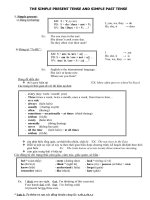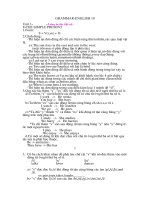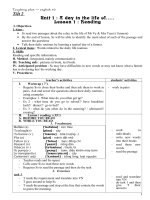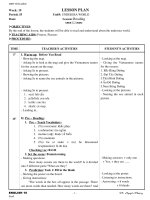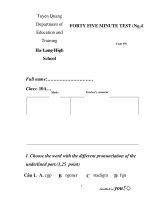Giáo Án Tiếng Anh 10 Global Review 2
Bạn đang xem bản rút gọn của tài liệu. Xem và tải ngay bản đầy đủ của tài liệu tại đây (146.83 KB, 16 trang )
thuvienhoclieu.com
REVIEW 2
Lesson 1: Language
I. OBJECTIVES
By the end of this lesson, students will be able to:
1. Knowledge
- Review the language they have learnt in Unit 4-5.
2. Core competence
- Develop critical thinking skills;
- Be collaborative and supportive in pair work and team work;
- Actively join in class activities.
3. Personal qualities
- Develop self-study skills.
II. MATERIALS
- Grade 10 textbook
- Computer connected to the internet
- Pictures, A0 paper
- Projector/ TV
- sachmem.vn
Assumptions
Anticipated difficulties
Students may find the lesson boring due to a large
number of language exercises.
Some students will excessively talk in the class.
Solutions
- Encourage students to work in pairs and in groups so that they
can help each other.
- Provide feedback and help if necessary.
- Explain expectations for each task in detail. Have excessive
talking students practise.
- Continue to explain task expectations in small chunks (before
thuvienhoclieu.com
Trang 1
thuvienhoclieu.com
every activity).
Board Plan
* Warm-up: Miming game
Pronunciation
Task 1: Escape the maze.
Task 2: Pair the cards.
Vocabulary
Task 1: Find the missing letters.
Task 2: Complete the sentences.
Grammar
Task 1: Read and circle the correct answers.
Task 2: Recall the information.
* Homework
Date of teaching
Review 2
Lesson 1: Language
III. PROCEDURES
Notes:
In each activity, each step will be represented as following:
*
Deliver the task
**
Implement the task
***
Discuss
**** Give comments or feedback
Stage
WARM-UP
Stage aim
To revise the
vocabulary related
MIMING GAME
* Teacher:
Procedure
Interaction
T-S
thuvienhoclieu.com
Trang 2
Time
5 mins
PRONUNCIATION
thuvienhoclieu.com
to the topic of Unit - lists out some key words of Unit 4 and Unit 5, e.g. generous, benefit,
4 and Unit 5.
community, application, invention, laptop, smartphone, experiment, hardware,
software, laboratory, equipment.
- has a volunteer come to the front then whispers one of the words into
his/her ears.
** Ss have to draw or mime the word. The rest of the class makes guesses. The
first student who correctly calls out the word gets a point.
*** The class plays the game together.
**** T checks if the answers are correct or incorrect and leads in the lesson.
To check if
TASK 1. ESCAPE THE MAZE (p.62)
students can
Escape the maze by connecting all words with the stress on the first syllable.
identify the correct Follow the examples and then listen to check your answers. Practise saying
stress placement
the words.
and provide further * T explains the activity.
pronunciation
** Ss try to escape the maze by connecting all words with the stress on the
practice.
first syllable. T tells them to study the examples. T asks them to say these
words aloud (increase, memory) with stress on the first syllable.
*** Ss work in pairs.
**** T gives feedback and discusses with the class. T plays the audio file for
students to listen and repeat.
Key:
To further practise
TASK 2: PAIR THE CARDS.
thuvienhoclieu.com
S
S-S
T-S
T-S
S-S
T-S
T-S
Trang 3
6 mins
6 mins
putting stress on
three-syllable
words
VOCABULARY
To check if
students can use
words and phrases
related to
volunteering and
inventions
To check if
students recognize
the differences
between -ing and ed, -ful and -less
adjectives
thuvienhoclieu.com
* T explains the activity.
- Put Ss in pairs and give each pair 10 cards.
- Write 20 familiar three-syllable words on the board:
+ 10 words with stress on the 1st syllable
+ 10 words with stress on the 2nd syllable.
- Ask Ss to copy words on their cards then shuffle the cards and spread them in
front of them.
** Ss take turns to open any two cards. If the stress pattern of the words on
the cards match, they read the words and keep both cards. If the stress
patterns don’t match or they can’t pronounce correctly, put them face down in
the same position. The winner is the player with the most cards.
*** Ss work in pairs.
**** T gives feedback and discusses with the class.
TASK 1: FIND THE MISSING LETTER.
What are the missing letters? Complete the sentences using the pictures to
help you. (p.62)
* T explains the activity. T demonstrates with the example by asking Ss to
guess what the picture shows and elicits the answer from the Ss.
** Ss work out the missing letters of the item by using the pictures. T reminds
them that these are the words they learnt in Unit 4 and 5.
*** Ss work in pairs.
**** T gives feedback and discusses with the class.
Key:
1. devices, communicate
2. donate, volunteer
TASK 2. COMPLETE THE SENTENCES USING THESE WORDS. THERE ARE SOME
EXTRA ONES. (p.63)
* T quickly reviews the differences between -ing and -ed, -ful and -less
adjectives. Then T explains the activity. T asks Ss to fill in the gaps with words
from the box and reminds them that there are some extra words that they
might not need.
thuvienhoclieu.com
Trang 4
S-S
S-S
T-S
6 mins
T-S
S-S
S-S
T-S
6 mins
T-S
GRAMMAR
To check if
students can use
the past simple,
past continuous,
present perfect,
gerunds, and toinfinitives.
- To memorise
information about
the origin of some
famous inventions.
- To practise the
use of past tenses.
thuvienhoclieu.com
** Ss do the task as required.
*** Ss exchange the answers.
**** T gives feedback and discusses with the class.
Key:
1. interesting / useful, careful
2. useless, interested
TASK 1: READ THE TEXT AND CIRCLE THE CORRECT ANSWERS. (p.63)
* T explains the context of the text.
- T tells Ss that new ideas are usually the result of careful planning and analysis,
but sometimes there are accidents which lead to useful inventions.
- T asks them to look at the pictures and guess what these inventions are.
** Ss read the passage and choose the correct answers as they read.
*** Ss exchange the answers with their partner.
**** T gives feedback and discusses with the class.
Key:
1. find
2. Discovering
3. was sitting
4. fell
5. was cleaning
6. discovered
7. have used
8. to make
9. making
TASK 2: RECALL THE INFORMATION
* T divides the class into groups of three. T has each student in the groups
choose a different invention from the text and pretend he/she is the person
who has invented or discovered the thing.
** Each student should try to explain how they did it using the information
from the text. E.g. I’m Isaac Newton and I discovered the law of gravity. I was
sitting under the apple tree when an apple fell on my head. I realized that
something made apples fall straight to the ground. That’s how I discovered
gravity.
thuvienhoclieu.com
Trang 5
S
S-S
T-S
T-S
6 mins
S
S-S
T-S
T-S
S-S
S-S
7 mins
WRAP-UP
HOMEWORK
thuvienhoclieu.com
*** Ss work in groups and then report to the whole class.
**** T gives feedback.
T asks Ss to talk about what they have learnt in the lesson.
T-S
To consolidate
what students have
learnt in the lesson.
To prepare for the Prepare for the next lesson: Review 2, Lesson 2 – Skills (1).
next lesson.
thuvienhoclieu.com
Trang 6
T-S
2 mins
T-S
1 min
thuvienhoclieu.com
REVIEW 2
Lesson 2: Skills (1) - Listening & Speaking
I. OBJECTIVES
By the end of this lesson, students will be able to:
1. Knowledge
- Review the Listening and Speaking skills they have learnt in Unit 4-5.
2. Core competence
- Develop critical thinking skill;
- Be collaborative and supportive in pair work and team work;
- Actively join in class activities.
3. Personal qualities
- Develop self-study skills.
II. MATERIALS
- Grade 10 textbook
- Computer connected to the internet
- Pictures, A0 paper
- Projector/ TV
- sachmem.vn
Assumptions
Anticipated difficulties
Students may find the lesson boring due to a large
number of language exercises.
Some students will excessively talk in the class.
Solutions
- Encourage students to work in pairs and in groups so that they
can help each other.
- Provide feedback and help if necessary.
- Explain expectations for each task in detail. Have excessive
talking students practise.
- Continue to explain task expectations in small chunks (before
thuvienhoclieu.com
Trang 7
thuvienhoclieu.com
every activity).
Board Plan
Date of teaching
Review 2
Lesson 2: Skills (1)
* Warm-up. Game: Hangman
Listening
Task 1: Listen and choose the best title.
Task 2: Listen and fill in the blanks.
Task 3: Complete the sentences.
Speaking
What other features should a smart home have? How will they help us?
Task 1: Brainstorming and mind mapping
Task 2: Presentation
* Homework
III. PROCEDURES
Notes:
In each activity, each step will be represented as following:
*
Deliver the task
**
Implement the task
***
Discuss
**** Give comments or feedback
Stage
WARM-UP
Stage aim
To give excitement to
students and lead in
the lesson.
Procedure
Interaction
GAME: HANGMAN
* T writes 9 blank letters on the board.
_____ ____
thuvienhoclieu.com
T-S
Trang 8
Time
5 mins
thuvienhoclieu.com
** Ss guess the letters in turn.
*** The class plays the game together. The first student to get the correct
answer is the winner.
**** T checks if the answers are correct or incorrect and leads in the lesson.
LISTENING
To practise listening for TASK 1. LISTEN AND CHOOSE THE BEST TITLE FOR THE TALK. (p.64)
main ideas
* T explains the activity. T asks Ss if they know what a smart home is.
** Ss read the titles, listen and choose the best one for the talk as they listen.
*** Ss work individually and then compare their answers with their friends.
**** T gives feedback and discusses with the class.
Key: A
To practise listening
TASK 2: LISTEN AGAIN AND FILL IN EACH BLANK WITH ONE WORD. (p.64)
for specific information * T explains the activity.
- T asks Ss to listen again. This time they are filling in notes, using one word for
each blank.
- Before having Ss do the task, T reviews the techniques for this type of
exercise, e.g. skimming through the note, predicting parts of speech and
answers based on context clues.
- T gives Ss some time to skim through the note and try to work out the
answers before they listen.
** Ss do as instructions.
*** Ss work individually and then compare their answer with the friend’s.
**** T gives feedback and discusses with the class.
Key:
1. voice
2. Lights
3. alarm
4. devices
To further practise
TASK 3. WORK IN GROUPS. COMPLETE THE SENTENCES WITH AS MANY
listening for specific
WORDS AS POSSIBLE.
information
* T puts Ss in groups and explains the task.
** T gives each group a handout with 4 sentences. Each sentence has only 3
thuvienhoclieu.com
Trang 9
S
S-S
T-S
7 mins
T-S
S-S
T-S
7 mins
S-S
S-S
T-S
7 mins
T-S
SPEAKING
To practise speaking
about smart homes
thuvienhoclieu.com
words given. T plays the audio (track 43). T can pause longer between
sentences or play the audio several times if necessary.
*** Ss listen to the audio and complete each sentence with as many words as
they can.
**** T gives feedback and discusses with the class.
1. ……………………………….. everything is controlled ………
2. ………….. turn on when ……………………………………….
3. ……………. your house temperature …………………….
4. …… that’s how technology …………………………………
Key:
1. Imagine living in a house where everything is controlled from a distance.
2. The lights turn on when you enter the room, and then turn off as you leave.
3. You can even control your house temperature, lights and devices from a
mobile phone when you are far from home.
4. And that’s how technology can make your life more enjoyable and
comfortable than ever.
WORK IN GROUPS. WHAT OTHER FEATURES SHOULD A SMART HOME HAVE?
HOW WILL THEY HELP US? USE THE EXPRESSIONS YOU LEARNT IN UNIT 5 TO
HELP YOU. (p.64)
Task 1: Brainstorming and mind mapping
* T explains the activity. T tells Ss that now they will be talking about smart
homes and suggesting new features. T gives each group a piece of A0 paper.
** Ss work in groups, try to brainstorm and make a mind map on the paper
given. Ss can draw and colour the mind map.
*** T walks round the class and gives support if necessary.
**** T gives feedback to each group before they present their work in front of
theclass.
Task 2: Presentation
* T asks Ss to look at the expressions in the box and reminds them to use them
in their discussion.
** Ss work in groups, use the mind map to prepare for a short presentation
about smart homes and suggesting new features.
*** T walks round the class and gives support if necessary. T encourages them
thuvienhoclieu.com
Trang 10
S-S
S-S
T-S
7 mins
T-S
S-S
S-S
T-S
T-S
S-S
9 mins
WRAP-UP
HOMEWORK
To consolidate what
students have learnt in
the lesson.
To prepare for the next
lesson.
thuvienhoclieu.com
to use the expressions provided.
**** T asks some groups to share their ideas with the rest of the class. T gives
feedback and discusses with the class. T praises for interesting ideas and good
delivery.
T asks Ss to talk about what they have learnt in the lesson.
Prepare for the next lesson: Review 2 - Skills (2) - Reading and Writing.
thuvienhoclieu.com
Trang 11
S-S
T-S
T-S
2 mins
T-S
1 min
thuvienhoclieu.com
REVIEW 2
Lesson 3: Skills (2) - Reading and Writing
I. OBJECTIVES
By the end of this lesson, students will be able to:
1. Knowledge
- Review the Reading and Writing skills they have learnt in Unit 4-5.
2. Core competence
- Develop critical thinking skills;
- Be collaborative and supportive in pair work and team work;
- Actively join in class activities.
3. Personal qualities
- Develop self-study skills.
II. MATERIALS
- Grade 10 textbook
- Computer connected to the internet
- Pictures, A0 paper
- Projector/ TV
- sachmem.vn
Assumptions
Anticipated difficulties
Students may find the lesson boring due to a large
number of language exercises.
Some students will excessively talk in the class.
Solutions
- Encourage students to work in pairs and in groups so that they can
help each other.
- Provide feedback and help if necessary.
- Explain expectations for each task in detail. Have excessive talking
students practise.
thuvienhoclieu.com
Trang 12
thuvienhoclieu.com
- Continue to explain task expectations in small chunks (before
every activity).
Board Plan
* Warm-up: Guessing game
Reading
Task 1: Match the highlighted words with their meanings.
Task 2: Read and choose the best answers.
Task 3: Play with cards.
Writing
Task 1: Brainstorm.
Task 2: Complete the application letter.
* Homework
Date of teaching
Review 2
Lesson 3: Skills (2)
III. PROCEDURES
Notes:
In each activity, each step will be represented as following:
*
Deliver the task
**
Implement the task
***
Discuss
**** Give comments or feedback
Stage
WARM-UP
Stage aim
To give excitement to
students and lead in
the lesson.
Procedure
GUESSING GAME
* T asks a student to come to the board. T shows him/her the key word
community service and asks him/her to explain this word to the whole class.
** This student can use any ways to describe the word, except for saying it
directly.
*** The class plays the game together. The fastest student to guess the correct
thuvienhoclieu.com
Trang 13
Interaction
T-S
S-S
S-S
Time
5 mins
READING
To practice
understanding words
from context.
To practice reading for
main ideas and specific
information
To further practice
reading for main ideas
and specific
thuvienhoclieu.com
key word is the winner of the game.
**** T checks if the answers are correct or incorrect and leads in the lesson.
TASK 1. READ THE TEXT. MATCH THE HIGHLIGHTED WORDS WITH THEIR
MEANINGS (p.64-65)
* T explains the context of the text.
- T writes down the words ‘community service’ and ‘volunteering’ on the
board. - T asks if Ss know the difference between them and tells them that
they will find the answer in the reading text.
** Ss complete the matching exercise by focusing on the highlighted words in
the text.
*** Ss check the answers as a class.
**** T gives feedback and discusses with the class and elicits the difference
between ‘community service’ and ‘volunteering’, e.g. Community service can
be either voluntary or compulsory, so volunteering is just one type of
community service.
Key:
1. c
2. b
3. a
TASK 2. READ THE TEXT AGAIN AND CHOOSE THE BEST ANSWERS. (p.65)
* T asks Ss to read the text again and complete the exercises.
** Ss do the task as required.
*** T checks the answers as a class.
**** T gives feedback.
1. B
2. C (Clue: For example, they may volunteer to meet new people, to develop
social skills, or to ‘find themselves’ (learn what they truly want in life)
3. A (Clue: In general, people may volunteer not just to have others, but to help
themselves)
TASK 3. PLAY WITH CARDS.
* T puts Ss into pairs. Ask each pair to prepare two quiz questions based on the
reading text and write them on cards or pieces of paper, e.g. How many types
thuvienhoclieu.com
Trang 14
S-S
5 mins
T-S
S
S-S
T-S
T-S
S
S-S
T-S
T-S
6 mins
6 mins
information
WRITING
To practice writing a
job application letter
thuvienhoclieu.com
of community service are there? Why does the writer think volunteering isn’t
always selfless?
** T collects the cards, shuffles them and spreads them (face down), on a table
in front of the class. Invite pairs to take turns to come to the table and turn
over a card.
*** Ss read the question and answer it. Ss get one point for a correct answer.
If the answer is wrong, they should put the card face down in the same
position.
**** T checks the answers and gives feedback.
COMPLETE THIS APPLICATION LETTER FOR A VOLUNTEER JOB BY WRITING A
SHORT PARAGRAPH. YOU MAY USE THE IDEAS BELOW TO HELP YOU. (p.65)
Task 1: Brainstorm
* T asks Ss to work in groups and brainstorm ideas to answer the question:
Which skills and qualities are needed to be a volunteer for an organization
collecting books for children?
** T asks Ss to share their ideas and write them on the board. Ss can use the
ideas in students’ book page 65.
*** Ss contribute to the discussion and note down the important points in
their notebooks.
**** T checks the answers and gives feedback.
Suggested ideas:
- Fond of reading
- Love helping others
- Love meeting new people
- Good interpersonal skills
- Be enthusiastic and helpful
- Develop social skills
Task 2: Complete the application letter.
* T explains the task: Ss must finish an application letter for a volunteer job.
Specifically, they need to write the reasons why they are interested in the job.
They should write 50 - 70 words. T draws their attention to the suggested ideas
and tells Ss they can incorporate them in their letters.
** Ss complete the application letter.
thuvienhoclieu.com
Trang 15
S-S
T-S
10
mins
T-S
S
T-S
T-S
S
10
mins
WRAP-UP
HOMEWORK
To consolidate what
students have learnt in
the lesson.
To prepare for the next
lesson.
thuvienhoclieu.com
*** T gives Ss enough time to write their letters. T walks round the class and
offers help.
**** T collects some or all Ss’ writings to give written feedback.
Sample answer:
I am very interested in the job because I am very fond of reading and I can sort
books very well. I also love helping others and meeting new people, especially
children. In fact, reading books to children is my favourite hobby. I am also
interested in this job because it will help me to develop my social skills, such as
communication and teamwork skills.
T asks Ss to talk about what they have learnt in the lesson.
Prepare for the next lesson: Unit 6, Lesson 1 – Getting Started.
thuvienhoclieu.com
Trang 16
T-S
T-S
T-S
2 mins
T-S
1 min


